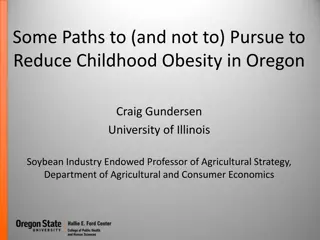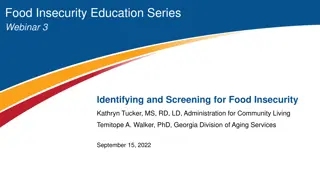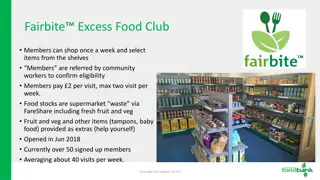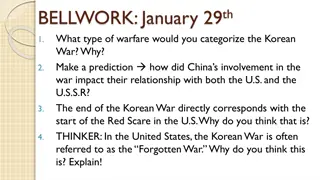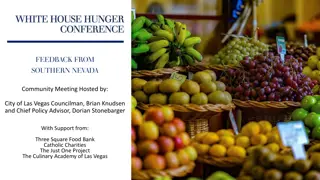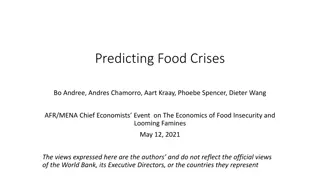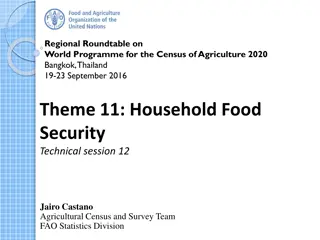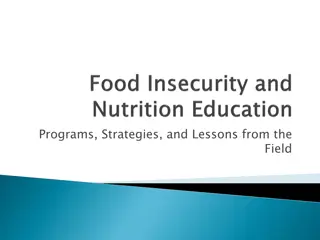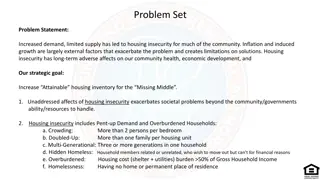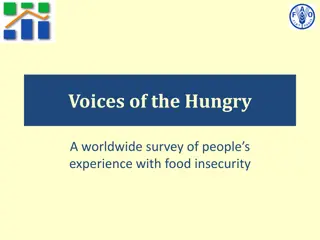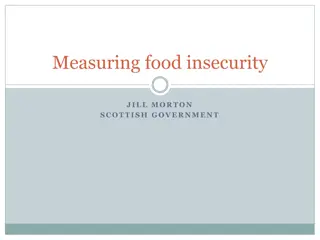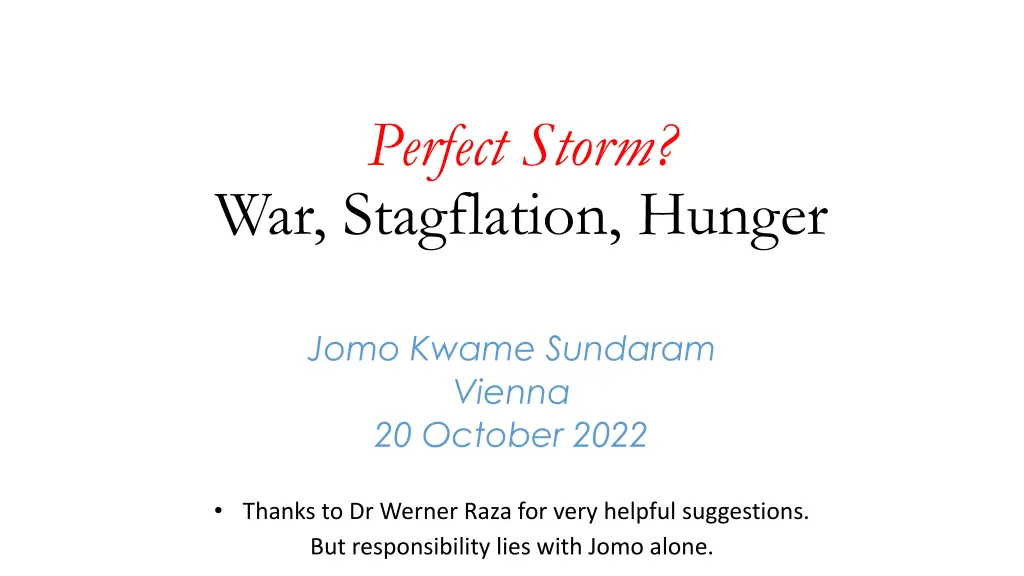
Understanding the Complexities of Malnutrition and Food Security Challenges
Explore the multifaceted issues of malnutrition, hidden hunger, obesity, and diet-related non-communicable diseases, along with the economic costs and solutions for better nutrition. Discover the impact on global health and the need for sustainable food systems and policies.
Download Presentation

Please find below an Image/Link to download the presentation.
The content on the website is provided AS IS for your information and personal use only. It may not be sold, licensed, or shared on other websites without obtaining consent from the author. If you encounter any issues during the download, it is possible that the publisher has removed the file from their server.
You are allowed to download the files provided on this website for personal or commercial use, subject to the condition that they are used lawfully. All files are the property of their respective owners.
The content on the website is provided AS IS for your information and personal use only. It may not be sold, licensed, or shared on other websites without obtaining consent from the author.
E N D
Presentation Transcript
Perfect Storm? War, Stagflation, Hunger Jomo Kwame Sundaram Vienna 20 October 2022 Thanks to Dr Werner Raza for very helpful suggestions. But responsibility lies with Jomo alone.
Malnutrition challenges Malnutrition > food security challenges: macronutrients (hunger) Hunger estimates narrow, conservative micronutrient [minerals, vitamins, trace elements] deficiencies (hidden hunger) diet-related non-communicable diseases Overweight, obesity Malnutrition widespread, costly
Malnutritions multiple faces > 722m people undernoursished in 2020 > 2 bn suffer micronutrient deficiencies Children: 161m. stunted, 51m. wasted, 99m. underweight 45% of 6.9 m. child deaths annually linked to malnutrition 42 m. overweight children < 5 years 2.1 bn overweight, ~700 m. adults obese
Economic costs of obesity McKinsey Global Institute (2014) Economic costs Armed conflicts $2.1 trillion Smoking $2.1 trillion About 1.9 ~ 2.1 billion people overweight (1/3 obese), i.e., 30% of global population Obesity $2.0 trillion
Hidden hunger Micronutrient deficiencies Micronutrients: vitamins, minerals, trace elements Dietary diversity: sustainable food system solution Nutrition supplements: very costly solution Some low-cost options, e.g., table salt iodization, fertilizers (soil plant human nutrition)
Diet-related non-communicable diseases Many non-communicable diseases (NCDs), i.e., not infectious, e.g., related to smoking, occupational safety, etc. Many food or diet-related NCDs Now mainly associated with obesity, overweight Also associated with excessive sugar, salt consumption Loosely, wrongly termed overnutrition
Better nutrition? Why? How? Malnutrition costs lives, money Healthier diets need better food systems Health, education, water, sanitation, lifestyles, etc. needed Appropriate policies, incentives, governance Sustainable food systems central Without full employment, decent work, need social protection floor to realize right to food
Commodity prices lower post-1970s Source: updated Grilli and Yang dataset
Tropical agricultural prices, 1865-2015 Real Tropical Agricultural Price Components 6.0 5.6 5.2 4.8 0.8 4.4 0.6 4.0 0.4 3.6 0.2 0.0 -0.2 -0.4 -0.6 1875 1900 1925 1950 1975 2000 Real price Non-trend Trend Super Cycle
Commodity terms of trade worse for most LMICs, with some levels close to 2012-14 Net commodity export terms of trade in stressed economies, June 2012=100 115 113 111 109 107 105 103 101 99 97 95 Jun 2012 Jun 2013 Jun 2014 Jun 2015 Jun 2016 Jun 2017 Jun 2018 Jun 2019 Jun 2020 Jun 2021 Apr 2013 Apr 2014 Apr 2015 Apr 2016 Apr 2017 Apr 2018 Apr 2019 Apr 2020 Apr 2021 Apr 2022 Dec 2012 Dec 2013 Dec 2014 Dec 2015 Dec 2016 Dec 2017 Dec 2018 Dec 2019 Dec 2020 Dec 2021 Aug 2012 Aug 2013 Aug 2014 Aug 2015 Aug 2016 Aug 2017 Aug 2018 Aug 2019 Aug 2020 Aug 2021 Feb 2013 Feb 2014 Feb 2015 Feb 2016 Feb 2017 Feb 2018 Feb 2019 Feb 2020 Feb 2021 Feb 2022 Oct 2012 Oct 2013 Oct 2014 Oct 2015 Oct 2016 Oct 2017 Oct 2018 Oct 2019 Oct 2020 Oct 2021 Sri Lanka Pakistan Tunisia Lebanon
Government initiatives Many private sector initiatives, progress need government encouragement, regulation Improve infrastructure, other efforts to reduce food losses, improve food safety Improve farmers planting, harvest and post- harvest practices Public, especially civil society campaigns to reduce food waste, malnutrition
Food production, supply, loss, waste Sustainable agriculture = Agroecology? Transition? Hunger associated with inadequate food supply Inadequate food supply not due to inadequate food production, but means, emergencies Food losses during production, storage, transport Food waste in consumption, e.g., sale, preparation
Undernourishment Inadequate dietary energy from macronutrients, measured as calories/joules, mainly from carbohydrates, usually cereals Prevalence of undernourishment (%): estimated undernourished ( hungry ) share of population Number of undernourished: estimated undernourished population Generally slow progress compared to poverty although poverty measures mainly consider cost of food viz income, to avoid hunger
Impact of Ukraine crisis on global food security Vicious cycles of climate change, conflict, poverty, food insecurity leaving millions very vulnerable Food production, import vulnerabilities and rigidities Declining international solidarity Climate-induced supply strains Grain hoarding, commodity speculation price crisis Identified after 2007-8 food price crisis, but unaddressed Careful: opportunistic and shortsighted responses to crisis e.g., backsliding on food system reform commitments
Stagflation drivers Global financial crisis Great Recession unconventional QE + fiscal austerity 2014 commodity prices collapse C19, war, sanctions supply-side disruptions Supply-side cost-push inflation Also: global warming effects worse in tropics Raising interest rates economic stagnation Interest rate hikes deliberate in 1980, 2022 1980 ended stagflation, but 2022 worsens it
War, sanctions, stagflation, hunger No to WTO waiver (vaccines, tests, treatments, PPE) SWIFT financial payments system undermined War sanctions siege: deliberate supply cuts Energy supplies to Europe disrupted Food, fertilizer supplies cut med.-term insecurity Wheat, fertilizer: protracted higher food prices Food, fertilizer for Asia, Africa food insecurity
Urgent action needed Support food importing countries, e.g., debt relief Tackle commodity speculation, enhance market, ownership transparency Reduce reliance on fertilizers, pesticides, fossil energy in food production Improve national, regional grain reserves, food security response systems Diversify food production, change trade flows
Thank you Carpe diem IDEAs website: www.networkideas.org For more, you can subscribe for free at https://jomoglobaldev.substack.com/publish or visit my website www.ksjomo.org

